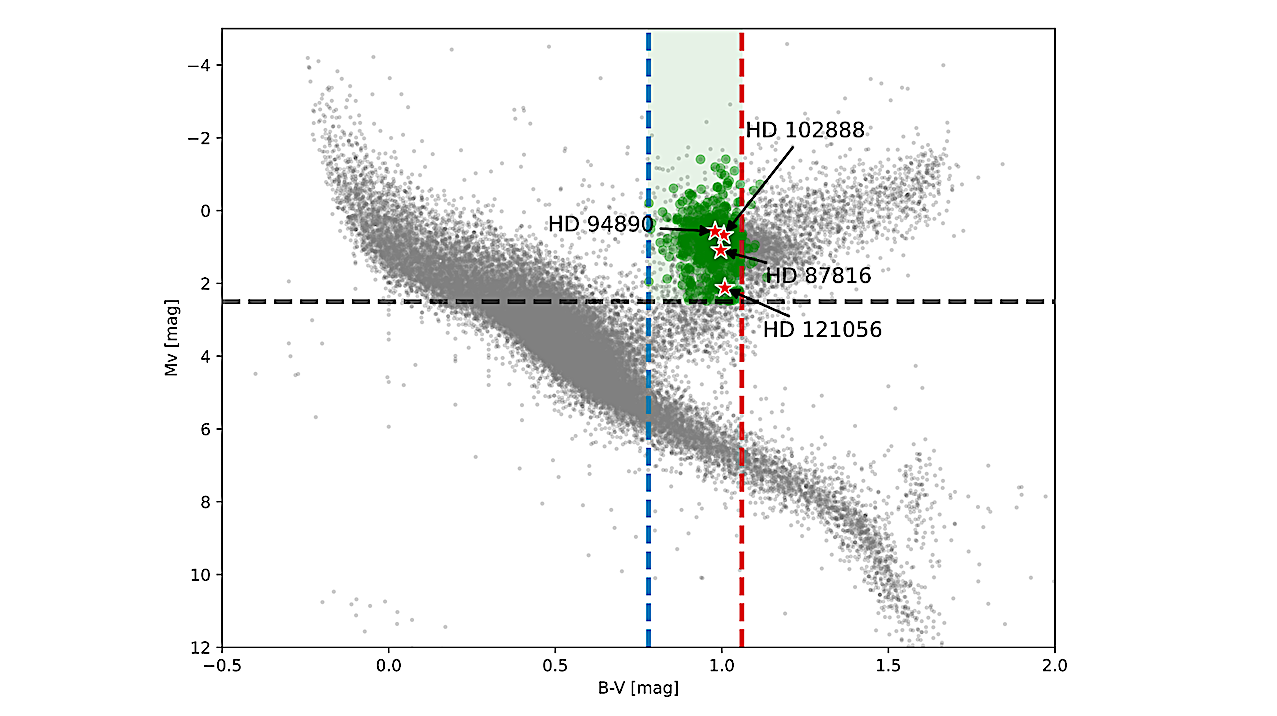CASCADES sample. Gray dots show all the stars of the Hipparcos sample with a precision on the parallax better than 14%. The green circles show the 641 targets of the CASCADES survey. The blue and red vertical lines represent the two B-V cutoffs that were introduced to select the targets, and the horizontal gray line shows the absolute magnitude threshold that was used. The four targets that are discussed in this work are represented by the four red stars. — astro-ph.EP
With around 200 detections of exoplanets around giant stars to date, our knowledge of the population of exoplanets orbiting evolved hosts more massive than the Sun remains limited.
The CORALIE radial-velocity search for companions around evolved stars (CASCADES) was launched in 2006 with the aim of improving our understanding of the demographics of exoplanets around intermediate-mass stars, by studying them once they have evolved off the main sequence.
We intend to refine the current sample of known exoplanets orbiting intermediate-mass (1.5 – 5 M⊙) giant stars of spectral types G and early K. We searched for exoplanets orbiting the four stars HD 87816, HD 94890, HD 102888, and HD 121056. We used data obtained with the CORALIE spectrograph, mounted on the Leonhard Euler Swiss telescope located at La Silla Observatory in Chile. We gathered high-precision radial-velocity measurements over more than ten years for each of the aforementioned targets. We started by performing a search for periodic signals in the radial-velocity time series of the four targets by using periodograms.
Following this, we fit for a Keplerian model using the significant peak with the highest power of the periodogram as the starting guess for the period. We then subtracted this model and repeated the procedure iteratively on the residuals until no significant peaks were found. Finally, to explore the posterior distribution of our models, the final solution was determined using a Markov chain Monte Carlo approach.
We report the discovery of five new massive planets around HD 87816, HD 94890, and HD 102888 as well as the presence of a distant, potentially substellar, companion around HD 102888. We confirm the presence of a previously announced exoplanet orbiting the HD 121056 multi-object system with a period of 89 days and propose an update to the period of the outer companion.
al-velocity Search For Companions Around Evolved Stars (CASCADES) IV: New Planetary Systems Around HD 87816, HD 94890, and HD 102888 And An Update On HD 121056
E. Fontanet, S. Udry, D. Ségransan, P. Figueira, J. A. Acevedo Barroso, B. Akinsanmi, M. Attia, M. Battley, S. Bhatnagar, M. Bugatti, Y. Carteret, H. Chakraborty, A. Deline, C. Farret Jentink, Y.G.C. Frensch, M. Houelle, B. Lavie, C. Lovis, M. Mayor, A. Nigioni, G. Ottoni, F. Pepe, D. J. M. Petit dit de la Roche, M. Shinde, N. C. Santos, S. Tavella, N. Unger, G. Viviani
Comments: Accepted for publication in A&A. Main text: 10 pages, 14 figures, 8 tables
Subjects: Earth and Planetary Astrophysics (astro-ph.EP); Solar and Stellar Astrophysics (astro-ph.SR)
Cite as: arXiv:2505.14317 [astro-ph.EP] (or arXiv:2505.14317v2 [astro-ph.EP] for this version)
https://doi.org/10.48550/arXiv.2505.14317
Focus to learn more
Submission history
From: Emile Fontanet
[v1] Tue, 20 May 2025 13:03:40 UTC (6,466 KB)
[v2] Mon, 23 Jun 2025 12:55:08 UTC (6,466 KB)
https://arxiv.org/abs/2505.14317
Astrobiology,
